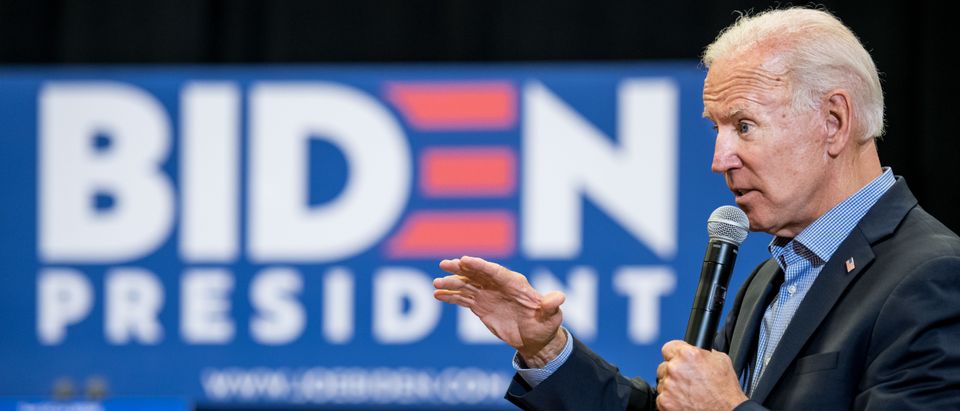Presumptive Democratic presidential nominee Joe Biden unveiled an updated climate plan July 14 that calls for a “clean energy revolution” with new infrastructure and clean energy policies.
The new climate plan is the second plank of the former vice president’s Build Back Better agenda and builds upon the campaign’s original climate agenda. The plan advocates for $2 trillion in federal spending over four years on a number of clean energy initiatives and infrastructure projects.
Biden’s clean energy initiatives revolve around a platform that aims to put the United States on an “irreversible path to achieve net-zero emissions” by 2050. In order to achieve this goal, the plan aims for a carbon-free power grid by 2035 that replaces conventional fossil fuels with renewable energy sources.

Presumptive Democratic nominee Joe Biden and Independent Vermont Sen. Bernie Sanders (Drew Angerer/Getty Images)
Included in the plan is a proposal to increase the federal government’s procurement system budget — which spends $500 billion every year — by an additional $400 billion in order to fund 100% clean energy and zero-emission vehicles.
In addition, Biden’s plan advocates for accelerated research and federal investment in battery technology and alternative energy sources in order to power a nationwide clean energy grid and expand the production of energy efficient vehicles.
Along with clean energy policies, the climate plan includes major infrastructure goals that Biden has promoted as a way to create new jobs, according to NPR. “When I think of climate change, the word I think about is ‘jobs’ — good-paying union jobs that’ll put Americans to work,” Biden said in prepared remarks last week in Wilmington, Delaware.
When I hear the words climate change, I hear the word “jobs.” Good paying, union jobs that will solve our jobs crisis while addressing our climate crisis. pic.twitter.com/7NRGNXsMI6
— Joe Biden (@JoeBiden) July 14, 2020
Biden’s infrastructure plan includes a “second great railroad revolution,” public transit systems in cities with more than 100,000 people, green spaces and water systems, new electricity grids and universal broadband. Also proposed is the construction of 1.5 million sustainable homes and upgrading millions of buildings to be more energy efficient.
These federal infrastructure investments would be backed by additional regulations committed to reducing the effects of greenhouse gas emissions and climate change. Biden also wants to create an Environmental and Climate Justice Division within the Department of Justice to go after polluters.
President Donald Trump’s campaign sharply criticized Biden’s climate plan in a statement July 14. The Trump campaign argued that eliminating oil, gas and coal from the U.S. power grid would cost “hundreds of thousands of blue-collar jobs” and stunt economic growth.
The Trump campaign also stated that Biden was “drastically underreporting” how much his plan would cost. The statement cited a study from the non-partisan American Action Forum which estimated that a de-carbonization plan would cost $5.7 trillion, much higher than the Biden campaign’s $2 trillion price tag.

President Donald Trump (Saul Loeb/AFP via Getty Images)
A Wood Mackenzie study cited by the Trump campaign further estimated that de-carbonization would cost the average American household nearly $2,000 a year. Given that Biden’s campaign advocates for a carbon-free power by 2035, households could potentially face $30,000 in costs over 15 years.
Trump campaign national press secretary Hogan Gidley said the plan reads like “a socialist manifesto” in a separate statement July 14. Gidley added that Biden’s agenda would be “beholden to the radical socialist ideology” of figures like Independent Vermont Sen. Bernie Sanders and Democratic New York Rep. Alexandria Ocasio-Cortez.
Oil and gas industry representatives like the American Petroleum Institute and the Western Energy Alliance have also criticized provisions in Biden’s climate plan that would phase out the use of fossil fuels in favor of renewable energy, The Washington Post reported.
Biden’s climate plan has received the support of major environmental groups like the Sunrise Movement. The Washington Post editorial board also called the updated climate plan “pretty good.”
Statement from @sunrisemvmt‘s @VarshPrakash on Biden’s clean energy plan (bolding is mine)https://t.co/XHhLKyvs4t pic.twitter.com/7zvah8QTuu
— Greg Krieg (@GregJKrieg) July 14, 2020
Democratic Washington Gov. Jay Inslee, who ran a climate-focused 2020 presidential campaign, also praised Biden on climate policy in an interview with New York Magazine.
The updated climate plan also comes amid policy recommendations that were released earlier this month by a joint task force led by Biden and Sanders. At the top of list is a six page blueprint on climate policy that includes the goal to de-carbonize the power grid by 2035 and other initiatives that appear in Biden’s climate plan.
Although neither the task force nor Biden’s climate plan explicitly mention the Green New Deal, Biden’s collaboration with Sanders and progressive Democrats like Ocasio-Cortez indicates that if elected president Biden could try to push through something similar.

Independent Vermont Sen. Bernie Sanders and Democratic New York Rep. Alexandria Ocasio-Cortez hold a news conference on the Green New Deal (Chip Somodevilla/Getty Images)
Ocasio-Cortez introduced legislation to implement the Green New Deal in February 2019, but the most comprehensive outline of what a Green New Deal would look like was released in a policy report in September 2018 by the left-wing think tank Data for Progress.
Data for Progress vice president Julian Brave NoiseCat told Slate last week that Biden’s climate plan echoed much of what was included in the think tank’s policy report. “Basically, Joe Biden endorsed a Green New Deal in our view,” he said.
Biden’s plan to get the U.S. to 100% renewable electricity by 2035 and zero emissions by 2050 is also found in Ocasio-Cortez’s bill. Proposals to build a “smart” power grid and upgrade buildings are also found in the Green New Deal, although the legislation takes it further by calling for “all existing buildings in the United States” to be upgraded.

Democratic New York Rep. Alexandria Ocasio-Cortez and Massachusetts Sen. Ed Markey unveil their Green New Deal resolution (Alex Wong/Getty Images)
The transportation and infrastructure components of Biden’s climate plan can also be found in some form within the text of the Green New Deal. Specific proposals found in both the climate plan and the bill are “zero-emission vehicle infrastructure and manufacturing,” more accessible public transit and high-speed rail.
Major differences between Biden’s climate plan and the Green New Deal are limited. Biden has not supported a ban on natural gas and oil fracking nor has he supported phasing out nuclear power, Slate reported. Biden’s climate agenda is also not attached to other progressive policies like Medicare for All.
Biden’s updated climate plan reveals how his agenda has shifted left since becoming the presumptive Democratic nominee. If elected president, it appears that Biden’s climate agenda would be the Green New Deal in all but name only.












